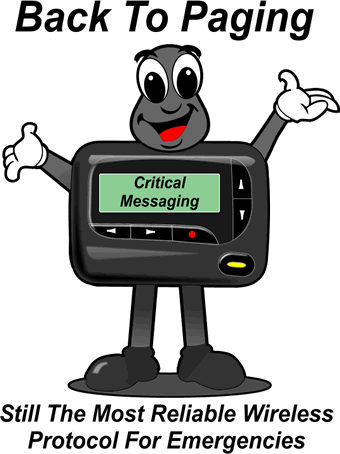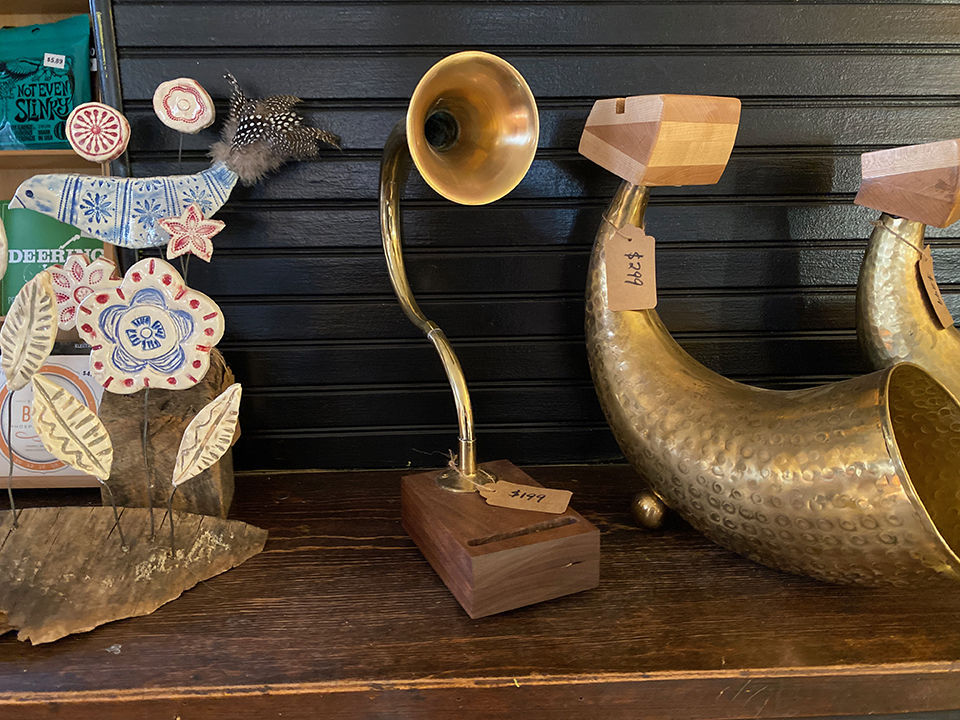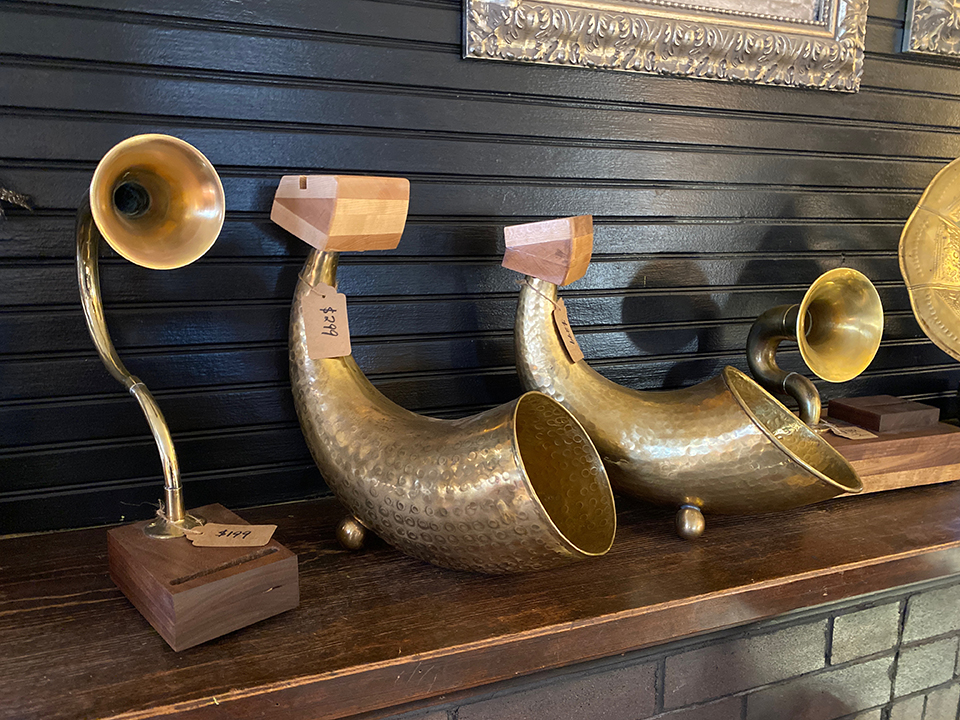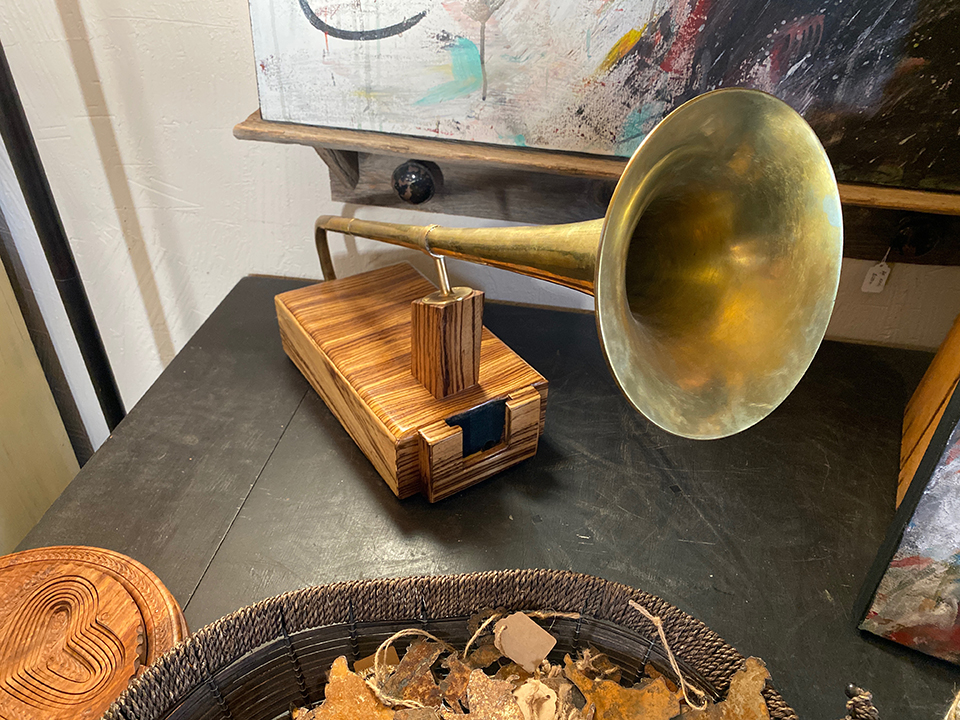

| Wireless News Aggregation |
|
Welcome Back To
The Wireless
|
NO POLITICS HERE
This doesn't mean that nothing is ever published here that mentions a US political party—it just means that the editorial policy of this newsletter is to remain neutral on all political issues. We don't take sides.
A new issue of the Wireless Messaging Newsletter is posted on the web each week. A notification goes out by e-mail to subscribers on most Fridays around noon central US time. The notification message has a link to the actual newsletter on the web. That way it doesn’t fill up your incoming e-mail account. There is no charge for subscription and there are no membership restrictions. Readers are a very select group of wireless industry professionals, and include the senior managers of many of the world’s major Paging and Wireless Messaging companies. There is an even mix of operations managers, marketing people, and engineers — so I try to include items of interest to all three groups. It’s all about staying up-to-date with business trends and technology. I regularly get readers’ comments, so this newsletter has become a community forum for the Paging, and Wireless Messaging communities. You are welcome to contribute your ideas and opinions. Unless otherwise requested, all correspondence addressed to me is subject to publication in the newsletter and on my web site. I am very careful to protect the anonymity of those who request it. I spend the whole week searching the INTERNET for news that I think may be of interest to you — so you won’t have to. This newsletter is an aggregator — a service that aggregates news from other news sources. You can help our community by sharing any interesting news that you find.
Editorial Opinion pieces present only the opinions of the author. They do not necessarily reflect the views of any of advertisers or supporters. This newsletter is independent of any trade association. I don't intend to hurt anyone's feelings, but I do freely express my own opinions.
HELP SUPPORT THE NEWSLETTER These are uncertain times.
|
||||||||||

|

|
|
Subscribe Here IT'S FREE * required field
|

|
|
Advertiser Index
|
Service Monitors and Frequency Standards for Sale
(Images are typical units, not actual photos of items offered for sale here.)
|
Passive Audio Amps For Smart Phones
Buy An Amp todayOh come on they are cool.These are acoustic amplifiers for smartphones. They don't need electric power to operate and there are no moving parts. They work like a megaphone (speaking-trumpet, bullhorn, or loudhailer). Everyone that I have shown one to has said something like “Wow, I want one of those!” So I have built a few of them. Of course there are more “Hi-Fi” ways to listen to audio on your smartphone but who would want to plug an elegant smartphone into some cheap, plastic gadget? Or even use Wi-Fi or Bluetooth, which are a pain in the neck to set up, even on a smartphone. These have been made with hardwood bases and some of them are exotic hardwoods with interesting grain patterns. The horns are polished brass — made from mostly old horns that had rubber bulbs on the ends and were used in “times gone by” by taxis and even clowns in circuses. These horns have been re-purposed, reshaped, soldered, and polished. They horns are now on display and for sale at:
The two large horns — the trombone and the gramophone — are difficult to pack and ship to they are for local pickup only. The remainder can be sent to you. I have the cowboy horn and the rest are in stock at the Colorado coffee shop. Please call for pricing and availability or stop in for a demo and a great cup of espresso. P.S. Allan, Virginia and I worked together at WebLink Wireless in Dallas. |
||||||||||

|

|

|

|

|

|
| Leavitt Communications |
|
|
|||||||||||||||||||||||||||
At this point, 5G is a bad jokeThinking of buying a new phone, just for high-speed mmWave 5G? Do yourself a favor: Don't.By Steven J. Vaughan-Nichols
Who doesn't want more bandwidth? I sure do, and I currently have 300Mbps to my home office via Spectrum cable. What I really want is a Gigabit via fiber optic to my doorstep. Maybe I'll get it someday. But, what I do know for a fact is I'm not going to get Gigabit-per-second speeds from 5G. Not now, not tomorrow, not ever. At the moment, there are a lot of things the telecomms are telling you in one ad after another that's just not true. I know – shocking news right? But, even by their standards, 5G is pretty bogus. Let's start with the name itself. There is no single "5G." There are, in fact, three different varieties, with very different kinds of performance. First, there's low-band 5G, which is the one T-Mobile likes to talk about. That's the one offering broad coverage. A single tower can cover hundreds of square miles. It's no speed demon, but even 20+ Mbps speeds are a heck of a lot better than the 3Mbps speeds that rural DSL sticks you with. And, in ideal situations, it may give you 100+ Mbps speeds. (Back in my home county in West Virginia, population about 7,200, I'd have killed for speeds like that.) Then, there's mid-band 5G. This runs between 1GHz and 6GHz and it has about half the coverage of 4G. You can hope to see speeds in the 200Mbps range with it. If you're in the United States, you rarely hear about this one. Only T-Mobile, which inherited Sprint's 2.5GHz mid-band 5G, is deploying it. It's going slowly, though, because a lot of its potential bandwidth is already being used. But, what most people want, what most people lust for is 1Gbps speeds with less than 10 milliseconds of latency. According to a new NPD study, about 40% of iPhone and 33% of Android users are extremely or very interested in getting 5G. They want all that speed and they want it now. And 18% even claim they understand the difference between the 5G network band types. I don't believe it. Because if they did, they wouldn't be in such a rush to get a 5G smartphone. You see, to get that kind of speed you must have mmWave 5G – and it comes with a lot of caveats. First, it has a range, at best, of 150 meters. If you're driving, that means, until 5G base stations are everywhere, you're going to be losing your high-speed signal a lot. Practically speaking, for the next few years, if you're on the move, you're not going to be seeing high-speed 5G. And, even if you are in range of a 5G base station, anything – and I mean anything – can block its high-frequency signal. Window glass, for instance, can stop it dead. So, you could have a 5G transceiver literally on your street corner and not be able to get a good signal. How bad is this? NTT DoCoMo, Japan's top mobile phone service provider, is working on a new kind of window glass, just so their mmWave 5G will work. I don't know about you, but I don't want to shell out a few grand to replace my windows just to get my phone to work. Let's say, though, that you've got a 5G phone and you're sure you can get 5G service – what kind of performance can you really expect? According to Washington Post tech columnist Geoffrey A. Fowler, you can expect to see a "diddly squat" 5G performance. That sounds about right. And, technically speaking what are diddly squat speeds? Try "AT&T with 32Mbps with the 5G phone and 34Mbps on the 4G one. On T-Mobile, I got 15Mbps on the 5G phone and 13Mbps on the 4G one." He wasn't able to check Verizon. That's not a typo, by the way. His 4G phone was faster than his 5G phone. It wasn't just him, since he lives in that technology backwater known as the San Francisco bay area. He checked with several national firms tracking 5G performance. They found that all three major US telecom networks' 5G isn't that much faster than 4G. Indeed, OpenSignal reports that US 5G users saw an average speed of 33.4Mbps. Better than 4G, yes, but not "Wow! This is great!" speeds most people seem to be dreaming of. It's also, I might add, much worse than any other country using 5G, with the exception of the United Kingdom. You're also only going to get 5G about 20% of the time. That's generic 5G, which includes T-Mobile with its great coverage, not that ultrafast mmWave 5G, with its tiny coverage, of your dreams. Unless you live or work right next to an mmWave transceiver, you're simply not going to see those promised speeds or anything close to them. The bottom line is, if you live in the fields and woods of rural America, you should definitely consider T-Mobile 600MHz 5G. But, if you're longing for super speed, forget about it. I don't think mmWave 5G will be worth the money until 2022. Frankly, I'm not counting on it being widely available until 2025 at the earliest. And, come the day it is, we'll still not see real-world Gigabit second speeds. |
| Source: |
|
|||||||||||||||
|
Paging Transmitters 150/900 MHz The RFI High Performance Paging Transmitter is designed for use in campus, city, state and country-wide paging systems. Designed for use where reliable simulcast systems where RF signal overlap coverage is critical.
Built-in custom interface for Prism-IPX ipBSC Base Controller for remote control, management and alarm reporting.
Prism-IPX Systems LLC.
11175 Cicero Dr., Alpharetta, GA 30022
|
The Wireless Messaging News
The Board of Advisor members are people with whom I have developed a special rapport, and have met personally. They are not obligated to support the newsletter in any way, except with advice, and maybe an occasional letter to the editor.
Can You Help The Newsletter?
You can help support The Wireless Messaging News by clicking on the PayPal Donate button above. It is not necessary to be a member of PayPal to use this service.
Newspapers generally cost
A donation of $50.00 would certainly help cover a one-year period. If you are wiling and able, please click on the PayPal Donate button above.
|
|||||||||||||||
|
|
| SALCOM |

|
|
|
| PRISM IPX Systems |
| Easy Solutions |
|
Providing Expert Support and Service Contracts for all Glenayre Paging Systems. The GL3000 is the most prolific paging system in the world and Easy Solutions gladly welcomes you to join us in providing reliable support to the paging industry for many more decades in the future. Easy Solutions provides cost effective computer and wireless solutions at affordable prices. We can help in most any situation with your communications systems. We have many years of experience and a vast network of resources to support the industry, your system and an ever changing completive landscape.
Please see our web site for exciting solutions designed specifically for the Wireless Industry. We also maintain a diagnostic lab and provide important repair and replacement parts services for Motorola and Glenayre equipment. Call or
Easy Solutions |
GLENAYRE INFRASTRUCTUREI would like to recommend Easy Solutions for Support of all Glenayre Paging Equipment. This Texas company is owned and operated by Vaughan Bowden. I have known Vaughan for over 35 years. Without going into a long list of his experience and qualifications, let me just say that he was the V.P. of Engineering at PageNet which was—at that time—the largest paging company in the world. So Vaughan knows Paging. GTES is no longer offering support contracts. GTES was the original group from Vancouver that was setup to offer support to customers that wanted to continue with the legacy Glenayre support. Many U.S. customers chose not to use this service because of the price and the original requirement to upgrade to version 8.0 software (which required expensive hardware upgrades, etc.). Most contracts ended as of February 2018. If you are at all concerned about future support of Glenayre products, especially the “king of the hill” the GL3000 paging control terminal, I encourage you to talk to Vaughan about a service contract and please tell him about my recommendation. Click on the image above for more info about advertising here. |
INTERNET Protocol Terminal
The IPT accepts INTERNET or serial messaging using various protocols and can easily convert them to different protocols, or send them out as paging messages. An ideal platform for hospitals, on-site paging applications, or converting legacy systems to modern protocols.
Additional/Optional Features
Prism-IPX Systems LLC.
11175 Cicero Dr., Alpharetta, GA 30022 |
||||||||||||||||||||||||||||||
3 Self-Defeating Habits That Destroy HappinessThe top 3 energy-draining, ambition-killing traits to lose.Posted Sep 18, 2020
Everyone struggles with negative internal voices; those nagging, critical, confidence-destroying voices that pop up when you're feeling anxious or want to try something new:
With the help of the right therapist, you can go to battle with self-defeating voices, unearth their origins, and evict them from your psychic. Even if they appear now and then (who doesn't suffer bouts of self-doubt or insecurity?), individual or group therapy can help you learn to manage self-defeating voices and keep them from undermining you. But what about self-defeating habits? Those ingrained patterns that feel as comfortable as your favorite cozy blanket. What do you do about those? Self-Defeating HabitsSelf-defeating habits generally fly just under the radar of your consciousness. You're aware of them, but not enough to challenge them. They've become so ingrained and habitual that you're quick to normalize them.
After every "but" is a reason not to justify poor choices and maintain your self-defeating patterns. To break free of them, let's take a closer look at the top three energy-draining, ambition-killing, and happiness-derailing traits that I've seen in my psychotherapy practice in the last 25 years. Top Three Self-Defeating Habits1. Complaining Complaint is the enemy of happiness. Whatever satisfaction it delivers can be considered empty calories at best. There's nothing wrong with feeling disgruntled, especially when it inspires us to grow and self-challenge, a dynamic Buddhists call "Turning poison into medicine." But chronic complaint without action forges patterns of negative thinking, pessimism, and hopelessness. It reinforces a sense of powerlessness in the face of frustration, saps your energy, and becomes a chronic source of discouragement for you and others around you. The result is an apathetic attitude that sucks the joy out of life. 2. Self-neglect No matter how you justify it, self-neglect leads to illnesses of the body, mind, and spirit. You can't sustainably enjoy life or develop resilience if you're sleep-deprived, don't exercise, ignore healthy eating habits, or rely on substances. The mind craves stimulation, the body craves movement, and the spirit craves balance—people who chose to ignore all three and engage in self-neglect craft a lifestyle that is destined to result in depression or social anxiety. article continues after advertisement 3. Procrastination Too often, we know what we should do, yet put off taking action. Procrastination leads to missed opportunities and regret. It feeds isolation, distrust, and emotional fragility. When we procrastinate, we deny ourselves a better way of being. Challenging Self-Defeating HabitsHere are three simple ways you can start to undo self-defeating habits today:
|
| Source: | Psychology Today |
|
Paging Data Receiver PDR-4 The PDR-4 is a multi-function paging data receiver that decodes paging messages and outputs them via the serial port, USB or Ethernet connectors. Designed for use with Prism-IPX ECHO software Message Logging Software to receive messages and log the information for proof of transmission over the air, and if the data was error free.
Prism-IPX Systems LLC.
11175 Cicero Dr., Alpharetta, GA 30022 |
Wireless Network Planners
|
|||||||||||
|
09.16.2020 07:00 AM There's No Better Time to Be an Amateur Radio GeekOnce considered a nerdy basement hobby, lo-fi transmissions from ordinary folks save lives during wildfires, hurricanes, and other climate disasters.
THE MOST IMPORTANT component of staying safe during an emergency is the ability to give and receive information. When the power goes out—which it often does, not only during wildfires but also during hurricanes, blizzards, earthquakes, and tornados—the internet doesn’t work and cellular networks crash with increased demand. In Northern California, we often have our electricity cut to prevent fire during high-risk times, leaving millions of customers in both metaphorical and actual dark. When people need information the most, they can’t get to it. So what’s the solution? Shortly after I started dating my boyfriend, Martin, a windstorm knocked out power in my Missoula, Montana, neighborhood. The electricity was only out for the night, and the contents of my refrigerator survived. I had a backup battery charger for my phone, and thanks to zero internet distractions and a fully charged Kindle, I read an entire book in a sitting, which I hadn’t done since the iPhone took up residence on my nightstand. The next time Martin came over, he asked what felt like a personal question, considering we were just getting to know each other. “What kind of emergency supplies do you have?” I was 41 years old and had kept myself alive thus far, so with moderate confidence I opened my pantry and revealed my full cache of emergency supplies—a box of Kind bars and a 12-pack of La Croix. I soon became the owner of a Lifestraw, headlamp, and list of things to consider. A couple of years later, we moved from Montana to Northern California. When the Camp Fire blazed through Paradise in November 2018—just 50 miles northwest of us—we felt the potential consequences of being cut off from information. The following spring, Martin got his amateur radio technician license, creating a lifeline for us independent of infrastructure. When preparing for a natural disaster, most people think of the basics—food and water—but those are only two pieces of a more complex puzzle, and I’m not talking about toilet paper. Do You Remember Walkie-Talkies?My best friend and I received a set of walkie-talkies in the fourth grade. The range was short, but because we lived across the street from each other and weren’t exchanging life-saving information, we were able to share facts such as “my mom is making cinnamon rolls.” Two-way handheld radios have evolved. In 1996 the Federal Communications Commission (FCC) authorized the Family Radio Service (FRS), which designated special radio frequencies for walkie-talkies so users can communicate without interference from radio stations or cordless phones. Bets of all, there’s no license required to operate. General Mobile Radio Service (GMRS) is similar to FRS, though it requires licensing through the FCC. The GMRS license costs $70 and lasts for 10 years, but doesn’t require an exam. One license covers an entire family, though operators must be over 18. FRS and GMRS are both walkie-talkies, but GMRS radios have the potential for increased range and clarity due to better antennas, higher transmit power, and access to repeaters. (Repeaters are basically relay stations that allow amateur radio operators to reach further than they can radio to radio.) FRS and GMRS don’t transmit information to or from non-paired devices, but they’re a great way to stay in touch with people you know, either in your home or around your neighborhood. Patsy Haggerty-Sollars, formerly of Paradise and now of Auburn, California, only knew to evacuate during the Camp Fire because a neighbor knocked on her door. Patsy left her mobile-home court with a friend—each in their own vehicle—but they got separated at the main road where police diverted traffic in multiple directions. “They weren't even trying to put the fire out,” Patsy said. “They were just trying to get the people out.” Haggerty-Sollars and her neighbor, Judy, were never far from each other, but first Judy lost her cellphone signal and then Haggerty-Sollars lost hers when she drove through flames—despite being in a rag-top convertible—because at that point there was no turning back. It’s not surprising they lost service. Seventeen cell towers burned the first day of the fire, which became the deadliest and most destructive wildfire on record in California. Two-way handheld radios could have provided a backup option, and some GMRS radios can transmit text messages and GPS locations, though only to other GMRS radios, not to cellphones or computers. If Martin and I have to evacuate, we’ll each have a walkie-talkie in our car in case we lose cell service. Evacuating is a realistic possibility as the worst of fire season hasn’t even started in California. Even so, since August 15, 3.5 million acres have already burned, which shatters the previous record of 2 million acres set in 2018. On the other side of the United States, East Coast residents brace for what the National Oceanic and Atmospheric Administration (NOAA) anticipates to be a more active hurricane season than usual. Forecasters predict the number of named storms to almost double this year, and they may extend into the Greek alphabet. Martin and I have been practicing using the radios room-to-room within the house and around the neighborhood, which is not exactly fun, because aren’t we already close enough during quarantine? How About The Cannonball Run?Another option for two-way radio communication is Citizens Band Radio Service (CBRS), which you may know as CB radio. Films like The Cannonball Run and Smokey and The Bandit popularized CB radios in the 1970s and 1980s. Since most new cars come hardwired with modern technology, it’s unlikely those devices will once again be mounted inside passenger vehicles (though truckers keep the CB dream alive), but they are an option for those living in high-risk areas who want to stay connected. People from coast to coast use dozens of apps, all dedicated to emergency preparedness. When hurricanes churn in the Atlantic and Gulf of Mexico, apps can help with navigating evacuation routes, locating temporary shelters, finding gas stations, and tracking the storms themselves. A phone full of apps feels like security, but when cellphone signals are spotty or lost entirely, they’re more like a debit card without a PIN. That’s where CB radios come in. While they seem like a dated form of communication, knowing that channels 9 and 19 are dedicated to relaying emergency information and traffic/road conditions boost their utility. Despite having a Subaru equipped with Starlink, I want one and Martin is down to install it. Do Regular People Use Scanners?Celine Negrete, of Grass Valley, California, recently bought a couple of police scanners for her six-person household. Negrete’s family doesn’t have a landline or cellular service inside their home, but thanks to a tree climber willing to shimmy up a 150-foot Ponderosa pine, they do have internet access. Celine can get a cell signal outside, but in the middle of the night she can’t receive alerts. Because Negrete’s house has internet, they can check social media groups for emergency information, but when the electricity goes out, the internet goes too. Their house is built from straw bales and the walls are thick, so they don’t receive a clear radio signal inside the house. During times of high fire risk, the family takes shifts going out to the car to listen to the radio, but now that they have scanners, they can monitor local emergency channels from bed. They just have to remember to keep plenty of batteries on hand. A Revved Up Form of CommunicationFor someone wanting a more complete package, amateur radio (a k a ham radio) is the way to go, although it involves a bit more planning and preparation before you can start using it. Before legally getting on the air, users must pass a 35-question written exam in order to receive their technician license and unique call sign from the FCC. After that there are two more levels—General and Amateur Extra—which require additional exams. Licenses are good for 10 years and almost anyone can hold one, with the exception of representatives of a foreign government. Although I spent most of my life thinking amateur radio was for geeks and grandparents, I now sit with Martin for twice-weekly check-ins with the local amateur radio club. It’s a way for ham radio operators to not only touch base with each other, but also to test their equipment. Amateur radio operators not only help themselves, but in emergencies they deploy to assist organizations like the Federal Emergency Management Agency (FEMA), Red Cross, and local public safety offices communicate and coordinate with the public, and with each other. Ham operators gain access to all of the amateur radio frequencies, which are almost infinite, while FRS and GMRS have limited access. It’s like FRS is a bicycle, GMRS is a scooter, and ham is a rocket that can reach the moon. That's not hyperbole. With the Amateur Extra license, amateur radio operators can communicate not only with other amateur radio operators around the world, but they can bounce messages off the moon. Do we need our messages to go to the moon in an emergency? Probably not, but a ham operator at any level can do something even better. In addition to all of the talking and listening capabilities, they can send texts and emails via their handheld radios. A text might say “we’re OK,” or it might say “send help.” Either way, it might be just the lifeline you need when other, more modern options have failed. The American Radio Relay League is a great place to get started exploring amateur radio, regardless of whether you’re interested in it as a quirky hobby or potential lifeline. ARES is the Amateur Radio Emergency Services, which has local groups across the United States and Canada. Amateur radio was critical during 9/11 and during devastating hurricanes like Katrina, Maria, and Sandy, where key infrastructure was destroyed. Even if you don’t think the time and investment is worthwhile, even looking into these options may transform the way you think about emergency readiness. |
| Source: | WIRED |
Brad Dye, Ron Mercer, Allan Angus, Vic Jackson, and Ira Wiesenfeld are friends and colleagues who work both together and independently, on wireline and wireless communications projects.
Click here
Note: We do not like Patent Trolls, i.e. “a person or company who enforces patent rights against accused infringers in an attempt to collect licensing fees, but does not manufacture products or supply services based upon the patents in question.” We have helped some prominent law firms defend their clients against this annoyance, and would be happy to do some more of this same kind of work. Some people use the title “consultant” when they don't have a real job. We actually do consulting work, and help others based on our many years of experience. “If you would know the road ahead, ask someone who has traveled it.” — Chinese Proverb WHAT IS 5G? 5G is the next generation of wireless networks and promises a mobile experience that's 10x to 100x faster than today's 4G networks. We say the word promise because we're in the early days of 5G. When more smartphones and networks support 5G tech, it will have far-reaching consequences for consumers, from the cars we drive (or that drive us) to the food we eat to the safety of our roads to the ways we shop to the entertainment we share with family and friends. And that doesn't include things we haven't yet imagined because we've never had the capability to unlock those new scenarios. Today, 5G may seem confusing even as it's widely hyped. We're here to help you sort fact from fiction, weed through the acronyms and jargon, and figure out when and how 5G can change the way you live. And we'll keep you from getting caught up in hyperbole — and empty promises. [ source ] |
Remote AB Switches ABX-1 switches are often used at remote transmitter sites to convert from old, outdated and unsupported controllers to the new modern Prism-IPX ipBSC base station controllers. Remotely switch to new controllers with GUI commands. ABX-1
ABX-3 switches are widely used for enabling or disabling remote equipment and switching I/O connections between redundant messaging systems. ABX-3
Common Features:
Prism-IPX Systems LLC.
11175 Cicero Dr., Alpharetta, GA 30022 |
| Leavitt Communications |
|
|||||||
| Inside Towers Newsletter |
|
NTIA Advisor Gets Trump Nod to Succeed FCC’s O’Rielly
The Trump Administration intends to nominate an FCC outsider to fill the seat of Republican Michael O’Rielly at the agency. National Telecommunications and Information Administration (NTIA) Senior Advisor Nathan Simington specializes in network and telecommunications policy. He works on 5G security in general, including supply chains, and the American Broadband Initiative, among other telecom issues, according to the White House. O’Rielly has served at the FCC for six years and was expected to remain on the Commission a third term. In August, Trump abruptly withdrew O’Rielly’s nomination with no explanation after the commissioner gave a speech opposing the FCC’s involvement in regulating social media, which the President favors. The Senate Commerce Committee had cleared O’Rielly for a third term and he awaited Senate confirmation when his nomination was pulled, Inside Towers reported. Prior to his appointment at NTIA, Simington was Senior Counsel to wireless company Brightstar Corporation. In this role, he negotiated deals with companies “across the spectrum of the telecommunications and internet industry, including most of the world’s leading wireless carriers,” stated the White House. As the head lawyer on the advanced mobility products team, he spearheaded international transactions in the devices, towers and services fields and forged what the Administration called “strong” relationships with telecom equipment manufacturers. O’Rielly can continue as an FCC Commissioner either until Congress adjourns or Simington has had a nomination hearing in the Senate and receives Senate confirmation, whichever comes first. In the wake of the unexpected withdrawal, the search for O’Rielly’s successor has been chaotic, and it was unclear whether a nomination would be submitted before the November election, reported The Verge. Also unclear is if the Senate will have time to act on Simington’s nomination before then. O’Rielly tweeted his support for his potential successor, saying: “I extend my sincere congrats to Mr. Simington for selection to join @FCC, and offer best wishes for a smooth confirmation process and successful term at the Commission.” NAB President/CEO Gordon Smith, also congratulated Simington, saying: “We wish him the best during the confirmation process and look forward to working with him on the critical issues affecting local radio and TV broadcasters should he be confirmed to the Commission.” |
| Source: | Inside Towers newsletter | Courtesy of the editor of Inside Towers Jim Fryer. Inside Towers is a daily newsletter by subscription. |
| BloostonLaw Newsletter |
Since my regular Mac Pro computer is in the Apple shop for service, this week's issue of BloostonLaw Telecom Update is being reproduced in its entirety (without editing) via the following link using my standby computer. It's like me — old and slow. I hope it works for everyone. Please use your browser's back button to return to The Wireless Messaging News.
|
|
||||||
| LETTERS TO THE EDITOR |
Brad: Glad you are staying well. Keep it up. The newsletter is a GEM. Will you please let your readers know I have 6 Sonic PTX150 VHF paging transmitters available. They are 100 watt, POCSAG/FLEX™ capable and covers 138-174 MHz. Power cords are included. They were removed WORKING from a county paging system and are guaranteed by me. $1,425.00 each.
Phil
Please contact Phil directly. The newsletter will receive a 10% to 15% commission on any sales made. (On the honor system — no contract.) |
|||||||||||||||||||||||
| THIS WEEK'S MUSIC VIDEO |
“Audion — Nico Bereciartúa”Playing For Change — Song Around The World
|
|
Source: |
 Best regards,  Newsletter Editor 73 DE K9IQY Licensed since 1957 |
Current member or former member of these organizations. | ||||
|
The National
Rifle Association |
MENSA MEMBER
|
A Public Library of

Paging and Wireless Messaging Information |
Wireless
 Messaging |
||
|
Critical Messaging
 Association |
European Mobile Messaging Association
Former Board Member |
ZP5TQ
 Radio Club of Paraguay |
Quarter Century

Wireless Association |
|
Back To Paging

Still The Most Reliable Wireless Protocol For Emergencies! |
American Association
of Woodturners |
U.S. Navy
 Radioman |
U.S. Navy Radioman  Second Class Petty Officer |
Boy Scouts of America
 National Honor Society |
Creator of the
 Paging Wheel of Fortune |
National Skeet
 Shooting Association |
Institute Electrical and

Electronics Engineers |
American Radio 
Relay League |
The Radio Club

of America |
Life is good!
|
|
|
CONTACT INFO & LINKS
|
Amateur Radio
|
VETERAN
 United States Navy |
|||
| Home Page | Directory | Consulting | Newsletters | Free Subscription | Products | Reference | Glossary | Send e-mail |